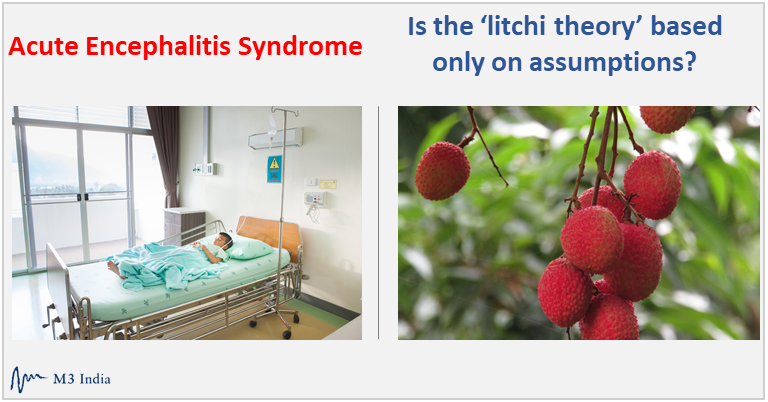AES deaths: Is the 'litchi theory' based only on assumptions?
M3 India Newsdesk Jun 25, 2019
In Bihar, litchis are harvested in massive quantities. While people are being asked to be careful about consuming the fruit, experts believe litchis are not the primary reason behind the outbreak of Acute Encephalitis Syndrome (AES) in the state.

In the wake of deaths of children due to Acute Encephalitis Syndrome (AES), the Union Minister of State for Health and Family Welfare last week linked it to litchi, a seasonal fruit produced in massive quantity in Muzaffarpur and adjoining districts during April, May, and June.
He said, “There are various reasons for deaths. But one reason is that children consume litchi on an empty stomach which causes Encephalitis.”
Last week Bihar Government in its advisory had asked parents not to feed litchi to children when they are on an empty stomach, while also advising against feeding unripe or semi-ripe litchis.
Few media reports too linked the deaths with litchi and warned people against consuming litchi.
Meanwhile, the Odisha government has decided to test the litchis, which are being sold across the markets in the state. The direction for the laboratory test of litchi was issued by Naba Das, the state minister for Health and Family Welfare.
Malnutrition, main cause?
T Jacob John, a retired professor of virology from Christian Medical College (CMC) Vellore, in an op-ed piece with The Hindu, said, “The disease affected only malnourished children between the ages of two and 10. A majority of them were from families camping in orchards for fruit harvesting. No child from the nearby towns fell ill. Children of well-to-do families never fell ill.”
Dr Vijay Kumar, who has been associated with research on AES, explicitly denied that only litchi is responsible for AES. He said, “Litchi is being unnecessarily blamed for AES. Malnutrition is the main reason for this. Those who are poor are the only victims.”
Dr Arun Shah, a paediatrician in Muzaffarpur who has been closely associated with research on AES, believes that poverty and malnutrition are the main reason for AES. He said, “This disease is attacking those children only who are very poor and malnourished. Unripe and rotten litchis trigger the AES.”
“We conducted research in 2014-2015, where we found that rotten and unripe litchi has more amount of the toxic substance—Methylene Cyclopropyl Glycine (MCPG). We also found the by-products of toxic substance in the urine of AES affected children, which indicates that they had consumed unripe or rotten litchi,” he added.
He stated if these poor children had access to healthy food supplements, they would not have died.
Dr AK Jaiswal, a paediatrician, said, “Clinically it is not yet established that litchi is the main cause of Acute Encephalitis Syndrome. Food for the brain is glucose, and if it doesn’t get glucose, then the function of the brain will stop, and it will start dying. When it happens, the child will become unconscious and show symptoms of chamki (seizures).”
“The litchi theory is based only on assumptions. Litchi from Muzaffarpur was sent to Atlanta and Vellore for research purpose. Litchi seed contains Hypoglycin-A or MCPG. There is a biochemical cycle in the body. If MCPG is consumed, then it alters the cycle which causes a decrease in the glucose level,” he added.
Amino acids to blame?
Vishal Nath, Director of ICAR-National Research Centre on Litchi, said, “There is no such substance which can directly impact children. Litchi is an acidic fruit. When litchi starts ripening in plants, the acid content is 2.5%. The acid converts into sugar in the ripening process.”
Unripe litchi’s taste is so bad that it is inedible for people. Consumption of unripe litchi can also give rise to acid-related complexities.
Speaking to M3 India, Nath stated, “All sapindaceous fruits’ seed has amino acid. In our research, we found the amino acid in traces in litchi seeds.”
He also said that most of the litchis were plucked and sent to market by June 7, so the cases should have come up then and not now.
The state government has deputed additional doctors to Muzaffarpur Hospital, and additional wards also have been established. Accredited Social Health Activist (ASHA) workers and Auxiliary Nurse Midwifery (ANM) have been told to hasten the awareness program.
When Bihar government prepared the Standard Operating Procedures (SOP) with UNICEF in 2015, the focus was not put on litchi consumption. When the SOP was updated in 2018, a separate chapter was introduced on litchi.
Till now, 152 children have reportedly died of AES. Government officials informed the number of patients coming to the hospital has been drastically decreasing and is hoping to control the disease further if the temperature of the city falls.
The author, Umesh Kumar Ray is a Patna-based freelance writer and a member of 101Reporters.com, a pan-India network of grassroots reporters.
-
Exclusive Write-ups & Webinars by KOLs
-
Daily Quiz by specialty
-
Paid Market Research Surveys
-
Case discussions, News & Journals' summaries